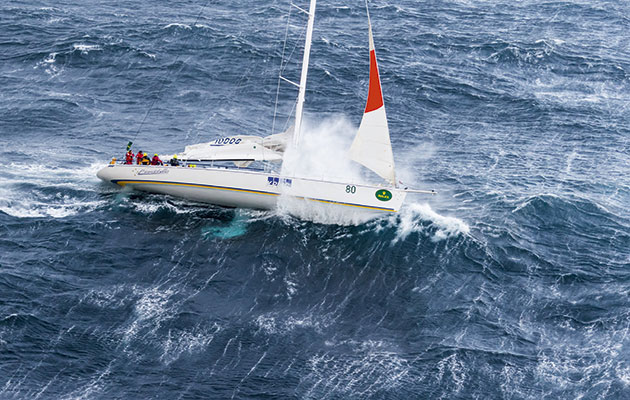We showed this image to ocean racing legend Loick Peyron to find out how he would deal with or avoid the situation.
Weather like this during the Sydney-Hobart is not a surprise for the guys who start the race. They know what to expect, and how rough it can become in the Tasman Sea. Therefore they know they need to prepare for the conditions.
This image shows there is quite a lot of wind – a good 35-40 knots I’d say. Fortunately for them, they are reaching at 90° true, and not beating, which would be particularly unpleasant. But, as can be seen from the wake, they are still moving through the water quite fast, probably between 8-11 knots.
Unless they have another problem, I imagine the reason they have dropped the main on this occasion is simply because of the conditions. It is quite a usual thing to do to slow down, but it must be carried out before the worst of the weather hits. Therefore it is always a question of timing. On this race however, crews will know what’s going to happen because the weather forecasts are so good. They even predict what will happen the week before, so everyone should be fully prepared.
Thankfully this team seems under control although the mainsail is not very well secured. There seems to be only one or two ties around, which is fine, but if for some reason they had to bear away downwind, then they risk losing the sail. Constant flapping in the wind could also lead to chafing and more serious damage to the sail if it is not secured or lashed down properly.
Because of the conditions and from a safety point of view, ideally there should be fewer crew on deck. This would help to minimise the risk, and to give crew time to rest after what may well have been a fairly tough time.
Basically in conditions like that you need to get the situation under control by slowing everything down. Once the main is down it is a matter of just sitting it out. Personally, I like to go down below and have a cup of tea, even when I am doing 25 knots under wingmast alone.
Part of the adventure, and the beauty of sailing should be to experience these conditions. Sharing tales of survival at the bar over a beer, recalling the size of the waves, and comparing the numbers on the anemometer to see who had the biggest wind in the fleet is all part of the fun – a big part of it.
Skip Novak’s Storm Sailing Techniques Part 6: preparing the deck for heavy weather
Yes, you could certainly avoid the situation in the first place but that would mean you would need to stay on shore in your cosy bed. Sailing is not all about flat water, palm trees, white beaches and bikinis. It is understanding that sometimes you have to wear a heavier bikini (ideally a waterproof one!) and embrace the challenging conditions.
The main thing is to be prepared and to anticipate. Anticipation is key all the time. Single-handed sailors need to anticipate weeks, days and hours before problems arise. Fully crewed yachts need to be prepared and well practised on what to do in these situations.
As a skipper it is important to respect the crew you are responsible for, and take time to understand them so you can make them feel comfortable. In this sort of situation, for example, some will prefer to be on deck in the fresh air rather than down below. A skipper who successfully manages little things like this makes a huge difference to morale on board and the all-important overall well-being of the crew.




